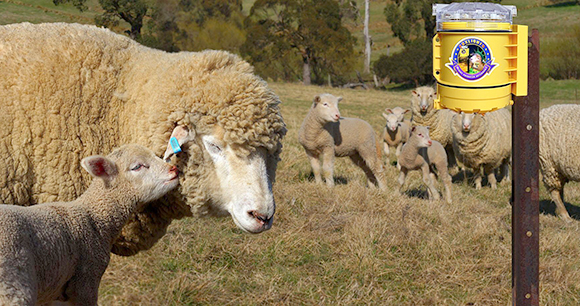by Suzanne Stone, senior representative of Defender of Wildlife’s Northwest Program, specializing in wolf conservation
Few conflicts are more challenging than wolves and livestock depredation encounters in the western United States. For centuries, wolves have paid the ultimate price for the presence of livestock on the landscape, resulting in their complete eradication from the West by the 1930s.
Now that wolves are being restored to their western habitat, the United States is again spending millions annually to kill wolves to protect livestock. Killing predators only briefly reduces predator numbers, with serious consequences to the proper functioning and health of ecosystems.

There are much better and more humane ways to address human conflicts with native predators. One of these new tools is the Foxlight, invented by Australian Ian Whalan to protect his lambs from foxes. Their unique features, including random flashing lights that automatically turn on at dusk and stay on throughout the night to make it appear that humans are patrolling, make Foxlights useful in remote livestock grazing situations.
After I was introduced to Ian in Australia by dingo researcher Dr. Brad Purcell, I brought Foxlights to the United States to determine if they could help keep wolves away from livestock, thus allowing more wolves to survive. My study was conducted with funding provided by the Oregon Department of Fish and Wildlife (ODFW) and a Christine Stevens Wildlife Award from AWI.
The ODFW agreed to allow me to test Foxlights in the field. However, the field test site, the Mount Emily pack territory in the Blue Mountain range, presented a serious challenge, as that wolf pack had already killed 15 sheep and one livestock guard dog in five attacks occurring in 2014 and 2015. While dogs are good deterrents most of the year, under some circumstances, such as when wolves are protecting their pups in dens, they perceive dogs as a threat to their pups and will kill or drive them away from their den sites.
On June 26, 2015, three or more Foxlights were placed on the perimeter of the sheep bedding grounds used by three sheep bands in the area. From the time the Foxlights were installed until August 4, 2015, no further sheep were killed by wolves at that location, despite continued documented wolf presence.
While the constant exposure to any protection method reduces the wolves' wariness, Foxlights appear to have successfully stopped wolf and sheep conflicts for more than a month. Due to the lengthy exposure to Foxlights, wildlife managers urged the sheep owner to consider switching to an alternate deterrent, such as keeping sheep in electrified night pens. The sheep owner refused and, as expected, the wolves eventually lost their fear of the Foxlights and began killing sheep again. Since the sheep owner refused reasonable deterrents to protect his sheep and because the grazing season was ending in late September, however, Oregon wildlife managers elected not to kill the Mt. Emily wolves. If Foxlights had not been used, it is almost certain that the Mt. Emily wolves would not have survived the summer grazing season.
The ODFW and other state wildlife agencies are now recommending Foxlights as a valuable short-term deterrent to help protect livestock from wolf depredation. While wolf exposure to the devices should be limited to maintain their effectiveness for longer periods, Foxlights are another effective tool to allow wolves and livestock to peacefully coexist on the landscape.